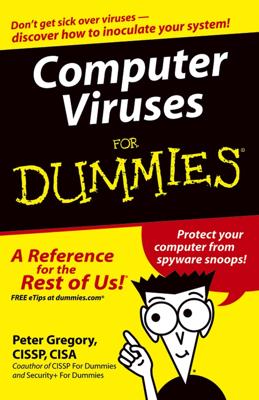Basics of viruses
A virus is a type of little program that loads on your computer without your knowing it and then starts running amok.A virus can replicate itself and pass itself along to infect other computers — but only by burying itself inside something larger, such as a Microsoft Word document or the programming code of a piece of software. It then takes a ride to another computer on a disk, or as an email attachment, or by some other method of file transfer.
In replicating themselves, viruses sometimes do their damage by making so many copies of themselves that they fill up your computer’s memory and cause it to crash.
In many cases, the replication and spread of a virus are secondary to its primary function, which is to perform some other task (sometimes harmless, sometimes electronically fatal) inside your computer. For example, a more malicious virus may take complete control of your computer and order it to do something horrible like delete its own hard drive.
Other viruses are intended as mere pranks: A good example is the Merry Christmas virus that simply flashes a harmless season’s greeting on your screen in December — end of story. Or so you think, but now it’s April Fools’ Day and the Merry Christmas virus doesn’t let you boot up your computer. Ha-ha-ha!
Basics of worms
Forgive the analogy, but think tapeworms — the ones your mom always thought you had in your gut when you were a kid. Here’s why the analogy is so fitting. Worms are similar to viruses in that they can copy themselves and do bad things to the computers they invade.Worms are also notorious loners, though, so they generally don’t attach themselves to the programming code of files or dig deeply in the out-of-the-way corners of disks or hard drives, as viruses do. Instead, worms send copies of themselves over the internet directly or they can hitch a ride in an email message.
Basics of macro viruses
A macro virus is a unique virus: Rather than be its own little program or application, it makes its appearance in the form of a macro embedded in a document file.Some experts claim that nearly three-quarters of all viruses are macro viruses, in part because they can embed themselves in your software and attach themselves to every document you create, which allows them to spread easily to others.
To understand macro viruses, you first have to understand macros. Many software applications, including Word, Excel, and PowerPoint, allow you to create macros, which are nothing more than a way to record long series of commands and then repeat the series of commands over and over again with just a keystroke or two.
In some cases, macros add themselves to your default document template so that they’re executed automatically every time you open an existing document or create a new one.
That’s how most macro viruses spread so quickly: Every time you create a new document in Word, the document is based on a default template named Normal.dotm that can contain font choices, margin settings, and, yes, even macros and macro viruses. If a macro virus is in your default template, you spread the virus every time you open or create a new document.
Basics of Trojan horses
A Trojan horse program tricks you into loading and running it by pretending to be something that it’s not. (Surely you remember this story from Greek mythology.) The perfect example of a Trojan horse is a file that masquerades as an antivirus software patch but is really a virus.Some Trojan horses are coupled with other types of viruses, such as macro viruses, which then generate new Trojan horses that are passed along to others.
Basics of bots
After a malicious entity infects a computer, it can gather computers together to perform specific tasks, like spam several million email accounts or try to take down a server. An infected computer is a bot, and many bots gather to form botnets. It’s not bad enough that your computer is infected — botnets are like zombie armies gathered to perform hideous tasks (and probably gather more victims like themselves).Basics of spyware
Computer privacy experts define spyware as any piece of software that gathers information and uses your internet connection to send that information somewhere else on your computer without your knowledge or approval. But why does the spyware do this?In many cases, the spyware is gathering information about you and your activities on your computer and sending that data back to the software manufacturer or some other data-collection company so that it can know more about you.

